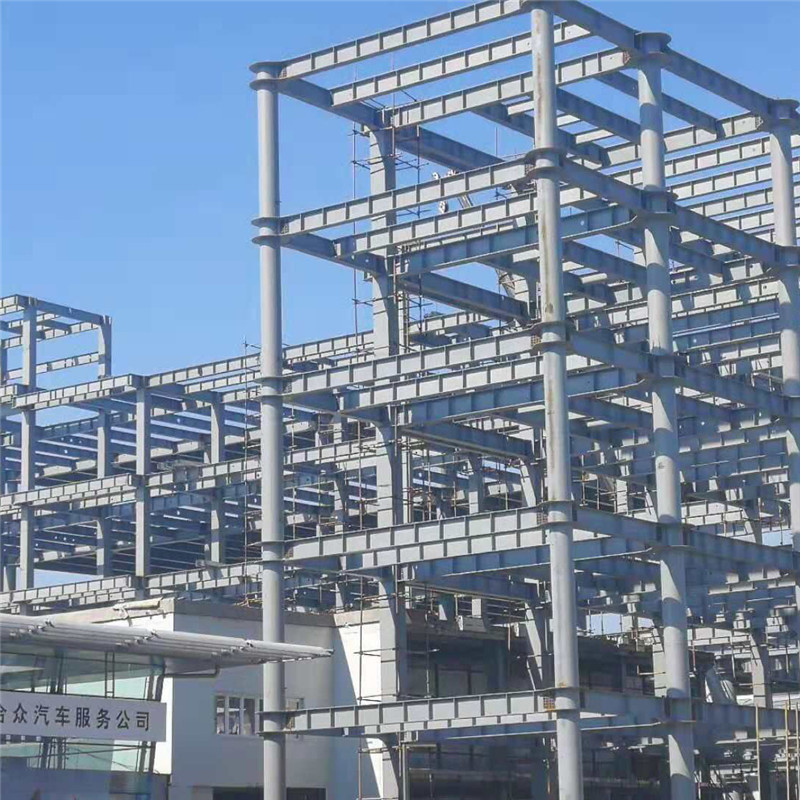A steel structure is a framework composed of steel components that are designed and fabricated to bear loads and provide stability in buildings, bridges, industrial facilities, and infrastructure projects.Steel structures are widely used in modern construction due to their strength, durability, versatility, and ease of assembly, making them ideal for projects requiring high load-bearing capacity and resistance to environmental stresses. The primary applications of steel structures include high-rise buildings, warehouses, factories, stadiums, airports, bridges, and towers, where their ability to support large spans and heavy loads without excessive weight provides significant advantages over traditional materials. Steel structures are also commonly used in pre-engineered buildings and modular construction, allowing faster assembly and cost-effective solutions for commercial and industrial spaces. One of the key benefits of steel structures is their high strength-to-weight ratio, enabling the creation of lightweight yet robust frameworks that reduce foundation requirements and construction costs. Steel’s flexibility and ductility allow it to withstand dynamic forces such as wind, earthquakes, and vibrations, ensuring structural stability and safety in harsh environments. Additionally, steel structures offer design flexibility, enabling architects and engineers to create complex shapes, long spans, and open floor plans without compromising strength. The prefabrication process further enhances efficiency, as components are manufactured off-site and assembled quickly on-site, reducing construction time and labor costs. Steel structures are also highly sustainable, as steel is recyclable and reusable, minimizing environmental impact and supporting green building practices. Advances in corrosion-resistant coatings and fireproofing technologies improve durability, extending the lifespan of steel structures even in challenging conditions. Modern steel structures incorporate advanced technologies such as computer-aided design (CAD) and building information modeling (BIM) to optimize design, accuracy, and coordination during construction. Compliance with international standards such as ASTM, AISC, and ISO ensures quality and safety in steel structures, making them reliable solutions for demanding applications. Overall, steel structures continue to play a vital role in modern construction, offering strength, flexibility, and efficiency for a wide range of architectural and engineering projects.
What Are The Key Advantages Of Steel Structures Compared To Traditional Construction Materials?
Steel structures offer several advantages over traditional construction materials such as wood, concrete, and masonry, making them a preferred choice for modern engineering and architectural applications. One of the primary benefits is their high strength-to-weight ratio, which allows steel components to support heavy loads while remaining lightweight, reducing foundation requirements and overall construction costs. This property makes steel structures particularly suitable for high-rise buildings, large-span roofs, and bridges where weight reduction is critical. Steel is highly durable and resistant to environmental factors such as moisture, pests, and fire when treated with appropriate coatings and fireproofing materials, ensuring long-term performance with minimal maintenance. Its ductility and flexibility allow it to withstand dynamic forces, including wind, earthquakes, and vibrations, providing structural stability and safety in challenging conditions. Steel structures are also highly versatile, enabling architects and engineers to design complex shapes, long spans, and open floor plans without the limitations imposed by traditional materials. Prefabrication is another major advantage, as steel components can be manufactured off-site and assembled quickly on-site, reducing construction time, labor costs, and material wastage. This efficiency makes steel structures ideal for modular and pre-engineered buildings, offering scalability and adaptability for future expansions. Sustainability is a key consideration, as steel is 100% recyclable and reusable, supporting eco-friendly construction practices and minimizing environmental impact. Advances in coating technologies and galvanization provide enhanced corrosion resistance, further extending the lifespan of steel structures. Steel structures are compatible with modern construction technologies such as computer-aided design (CAD) and building information modeling (BIM), enabling precise planning, efficient resource allocation, and seamless integration with other building systems. Compliance with industry standards such as ASTM, AISC, and ISO ensures quality, safety, and reliability, making steel structures a trusted solution for demanding applications. In addition to structural benefits, steel offers aesthetic appeal, as its sleek appearance and ability to create expansive spaces complement contemporary architectural designs. Overall, steel structures combine strength, flexibility, efficiency, and sustainability, making them a superior alternative to traditional materials for modern construction projects.
What Are The Main Types Of Steel Structures, And How Are They Used In Construction Projects?
Steel structures can be classified into several types based on their design and application, each serving specific purposes in construction projects. The main types include frame structures, truss structures, portal frames, shell structures, and pre-engineered buildings, each offering unique benefits for different construction needs. Frame structures are composed of vertical columns and horizontal beams connected to form a rigid framework, commonly used in high-rise buildings, warehouses, and industrial facilities due to their strength, stability, and load-bearing capacity. Truss structures consist of triangular units connected by joints, providing lightweight yet strong frameworks ideal for roofs, bridges, and towers where large spans and minimal material usage are required. Portal frames are designed with rigid joints and are widely used in warehouses, factories, and agricultural buildings for their ability to support heavy loads and resist wind and seismic forces. Shell structures are curved or arched designs used in roofs, domes, and hangars, offering aesthetic appeal and structural efficiency by distributing loads evenly across the surface. Pre-engineered buildings (PEBs) are factory-manufactured components that are assembled on-site, providing cost-effective and time-saving solutions for commercial and industrial spaces. These structures are highly customizable, allowing integration of insulation, ventilation, and lighting systems for enhanced functionality. Each type of steel structure is designed to meet specific performance requirements, including strength, durability, and resistance to environmental factors. Advances in steel manufacturing and fabrication technologies, such as laser cutting, welding, and 3D modeling, have further improved precision and efficiency in structural design. Steel structures are compatible with modern construction methods, including modular and prefabricated approaches, enabling faster assembly and scalability. Compliance with international standards such as ASTM, AISC, and ISO ensures quality and safety, making steel structures reliable solutions for diverse applications. As urbanization and industrialization continue to grow, steel structures remain a cornerstone of modern construction, offering strength, flexibility, and sustainability to meet the demands of contemporary engineering and architectural projects.


